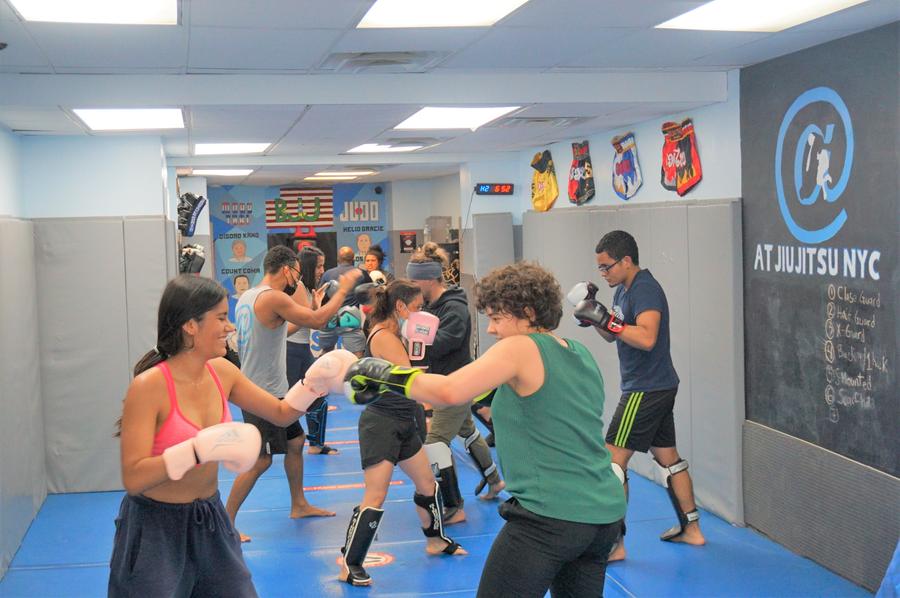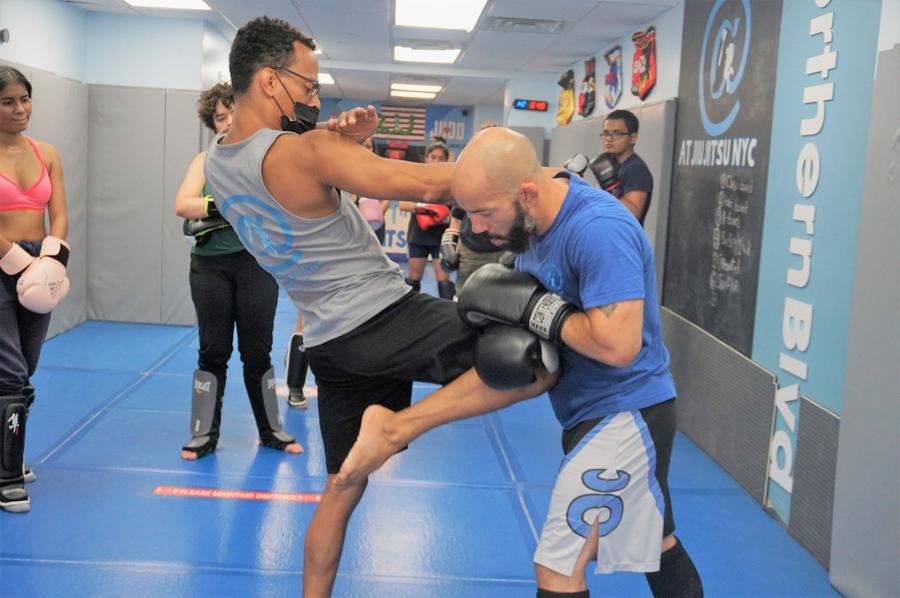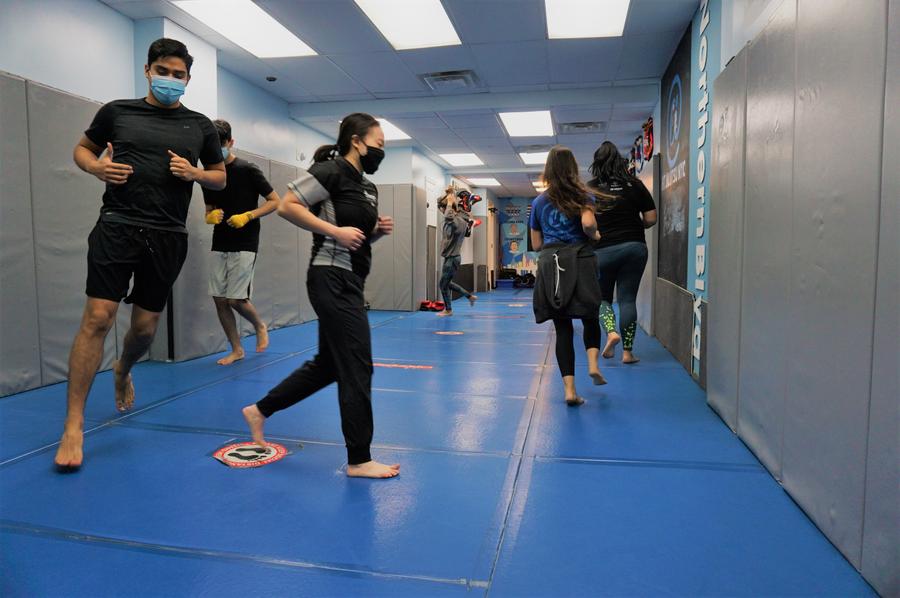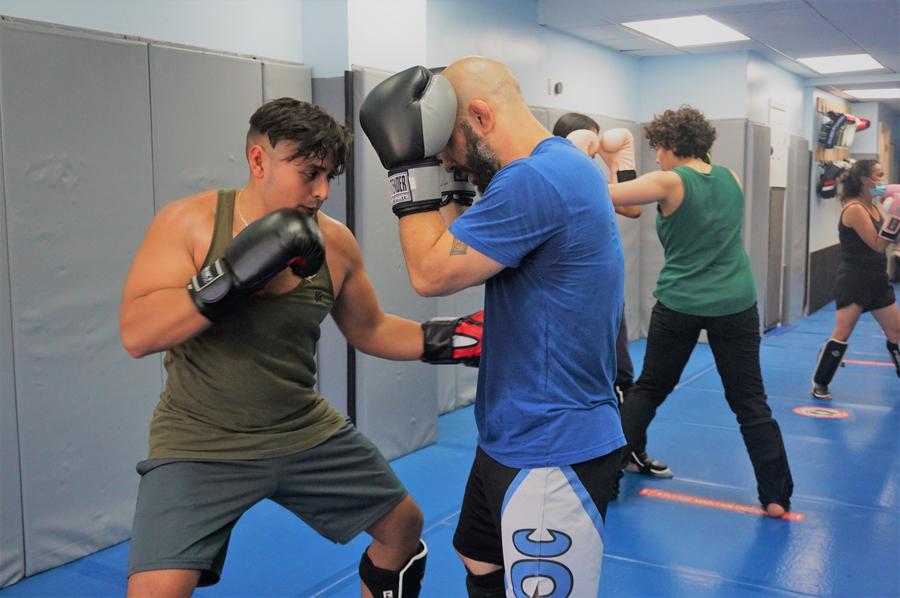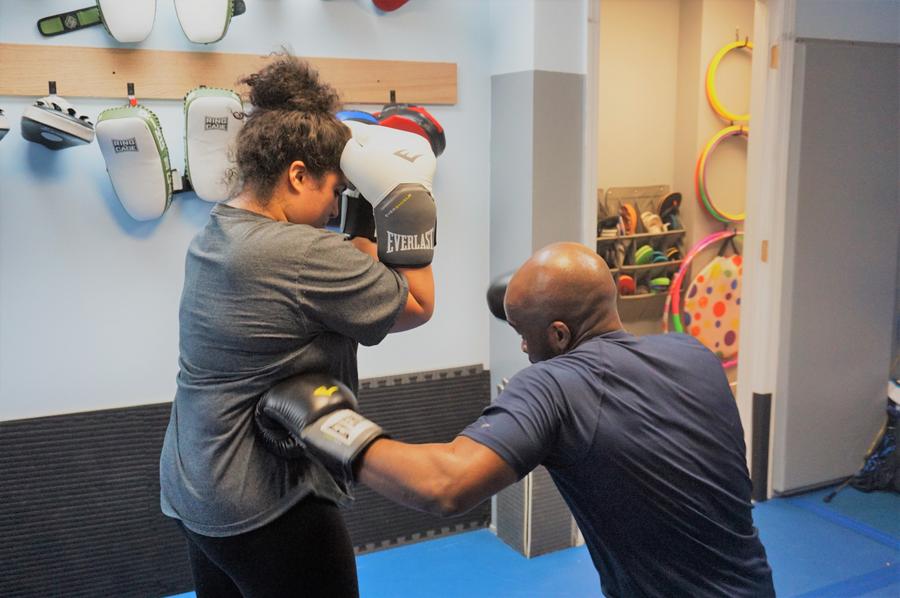Kickboxing
Dive into the world of kickboxing: a blend of karate, Muay Thai, and boxing. Learn about its techniques, history, and benefits for fitness and self-defense.
Kickboxing
Why learn kickboxing?
Kickboxing offers a comprehensive workout, toning muscles, enhancing cardiovascular health, and imparting valuable self-defense skills.
What differentiates kickboxing from Muay Thai?
While both are striking martial arts that incorporate punches and kicks, they have distinct techniques, origins, and fighting stances. Muay Thai, known as the ‘Art of Eight Limbs,’ also incorporates elbows and knee strikes, emphasizing clinch fighting.
Kickboxing and Muay Thai are both prominent stand-up fighting styles, but they have distinct characteristics:
- Techniques: Kickboxing focuses on punches, kicks, and footwork. In contrast, Muay Thai utilizes punches, kicks, elbows, knees, and clinching techniques.
- Stance: Muay Thai fighters adopt a more upright stance, while kickboxers often use a side-on stance similar to traditional boxers.
- Origins: Kickboxing has its roots in karate and boxing and became popularized in Japan and later in the U.S. Muay Thai is an ancient martial art from Thailand, deeply embedded in the country’s culture.
- Rounds and Fight Duration: Professional Muay Thai bouts usually have 5 rounds, while kickboxing can vary, often with 3 or 5 rounds.
- Cultural Significance: Muay Thai has spiritual elements, with fighters performing the “Wai Kru” dance before bouts to respect their teachers. Kickboxing doesn’t have such rituals.
Health Benefits of Kickboxing: Exploring its impact on cardiovascular health, muscle tone, and mental well-being.
How does kickboxing enhance overall well-being?
As a comprehensive fitness regimen, kickboxing boosts cardiovascular health, shapes muscles, and fosters mental resilience, making it a holistic approach to wellness.
-
Cardiovascular Health:
- Intensive Cardio Workout: The blend of aerobic and anaerobic exercises in kickboxing pushes the cardiovascular system, enhancing heart efficiency and lung capacity.
- Endurance Building: Regular training improves stamina, allowing practitioners to perform high-intensity activities for extended periods without fatigue.
- Blood Pressure and Cholesterol: Regular kickboxing can help regulate blood pressure and reduce bad cholesterol levels, minimizing the risk of heart diseases.
-
Muscle Tone and Strength:
- Full-body Workout: Unlike some workouts that focus on specific muscle groups, kickboxing is a full-body exercise. From leg muscles activated during kicks to core engagement for balance and arm muscles for punches, every part gets a workout.
- Core Strengthening: The rotational movements in punches and the need for balance during kicks fortify the core muscles.
- Bone Density: Weight-bearing exercises in kickboxing, like jumping and resistance training, can improve bone density and reduce the risk of osteoporosis.
-
Mental Health:
- Stress Reduction: The physical exertion in kickboxing releases endorphins, the body’s natural mood boosters, helping alleviate stress and elevate mood.
- Mental Clarity: Focusing on techniques, combinations, and sparring sessions can enhance concentration and mental clarity. It’s an activity that requires being “in the moment,” which can serve as a form of active meditation.
- Confidence and Self-Esteem: Learning a new skill, mastering techniques, and seeing physical improvements can significantly boost one’s self-confidence and self-esteem.
- Social Interaction: Kickboxing classes offer social interaction, providing a sense of community and belonging, which can be vital for mental well-being.
-
Flexibility and Agility:
- Dynamic Stretches: Kickboxing sessions often start with dynamic stretches, which, over time, can improve flexibility.
- Improved Reflexes: The fast-paced nature of kickboxing—dodging, blocking, and striking—sharpens reflexes and agility.
-
Weight Management:
- Calorie Burn: A typical hour of kickboxing can burn a substantial number of calories, depending on intensity, making it an effective workout for weight loss or maintenance.
- Increased Metabolism: The muscle-building aspect of kickboxing can elevate resting metabolic rate, aiding in calorie burn even when not actively training.

Kickboxing for Kids: Benefits and considerations for younger practitioners.
Why consider kickboxing for kids?
Kickboxing offers younger practitioners a blend of physical fitness, discipline, and self-confidence, while also teaching them vital self-defense techniques.
Benefits:
- Physical Fitness: With childhood obesity on the rise, kickboxing provides an engaging way for kids to stay active, improving cardiovascular health, flexibility, and muscle strength.
- Discipline: Martial arts, including kickboxing, instill a sense of discipline. Kids learn the importance of consistent effort, punctuality, and respect for instructors and peers.
- Self-Defense: While it’s hoped they’ll never need to use it, kickboxing equips kids with self-defense skills, boosting their confidence.
- Social Skills: Group classes promote teamwork, communication, and friendship, helping kids improve their interpersonal skills.
- Mental Focus: Kickboxing requires concentration, helping children improve their attention span and focus, which can be beneficial in academic settings as well.
- Boosted Self-Esteem: Achieving milestones, whether mastering a new move or advancing to a new belt, boosts a child’s self-esteem.
Considerations:
- Safety First: It’s crucial to find a reputable kickboxing school that prioritizes the safety of its young students. Instructors should be trained in teaching kids and understand their physical and psychological development stages.
- Appropriate Techniques: Some kickboxing techniques might be advanced or unsafe for younger practitioners. Classes for kids should be tailored with age-appropriate techniques and intensity.
- Equipment: Children should wear protective gear, including gloves, shin guards, headgear, and mouth guards, even during light sparring or training.
- Supervision: Kids’ kickboxing sessions should always be supervised by trained instructors. Parents should also remain informed about what their children are learning and practicing.
- Mental Well-being: While discipline is a part of martial arts, it’s essential to ensure that the training environment is positive and encouraging, without undue pressure or unrealistic expectations.
What is the influence of martial arts on adults’ well-being
Martial arts is a powerful catalyst that amplifies an adult’s physical agility and bolsters mental fortitude. Embracing this practice not only refines your physique but also sharpens your mental clarity, focus, and confidence. Thinking of embarking on this transformative journey? Dive deeper to understand how martial arts might be the change you’ve been seeking – and consider taking the next step by exploring our sign-up and schedule options.
Kickboxing Equipment: Discussing gloves, shin guards, and other essential gear.
What equipment is necessary for kickboxing?
Kickboxing requires specific gear like gloves, shin guards, and headgear to ensure safety during rigorous training and sparring sessions.
Here Is your comprehensive guide to kickboxing equipment. Explore the essentials—from gloves and shin guards to mouthguards—and understand their importance in training.
-
Gloves:
- Purpose: Gloves protect both the wearer’s hands and their opponent from injuries. They cushion the impact, safeguarding knuckles, wrists, and fingers.
- Types: There are training gloves for general practice, bag gloves for punching bag workouts, and sparring gloves designed for safety during practice bouts with partners.
- Material & Padding: Quality gloves are often made of leather or synthetic materials, with ample padding to absorb shock.
-
Shin Guards:
- Purpose: Kickboxing involves powerful leg strikes. Shin guards protect the shins from bruises and more severe injuries during sparring.
- Fit & Material: They should fit snugly and be made of durable materials like leather or high-quality synthetics, with padding to cushion impacts.
-
Headgear:
- Purpose: Headgear, or head protectors, safeguard against head injuries, especially during sparring.
- Coverage: Good headgear offers protection for the forehead, temples, cheeks, and chin. Some also have a face cage to protect the nose and eyes.
-
Mouth Guards:
- Purpose: Mouth guards shield the teeth, gums, and lips from potential damage. They also help reduce the risk of concussions by absorbing and dispersing the force from a strike to the face.
- Custom vs. Standard: While standard mouth guards are available, custom-fit options—molded to an individual’s teeth—offer the best protection and comfort.
-
Hand Wraps:
- Purpose: These are cloth strips wrapped around the hands beneath the gloves. They stabilize the wrist and protect the small bones in the hands.
- Material & Length: Usually made of cotton, they come in varying lengths. The choice depends on personal preference and hand size.
-
Ankle Guards:
- Purpose: These offer support to the ankles and protect against scrapes during training.
- Fit: They should be tight enough to offer support but not so tight as to restrict movement.
-
Groin Protectors:
- Purpose: Especially essential for male practitioners, these protectors shield the groin area from unintentional strikes.
- Fit & Material: A snug fit is crucial, and they’re typically made of foam padding with a plastic or metal shield.
-
Training Bags:
- Purpose: Used for practicing strikes, kicks, and combinations.
- Types: Heavy bags are for power shots, while speed bags help improve hand-eye coordination and reflexes.
